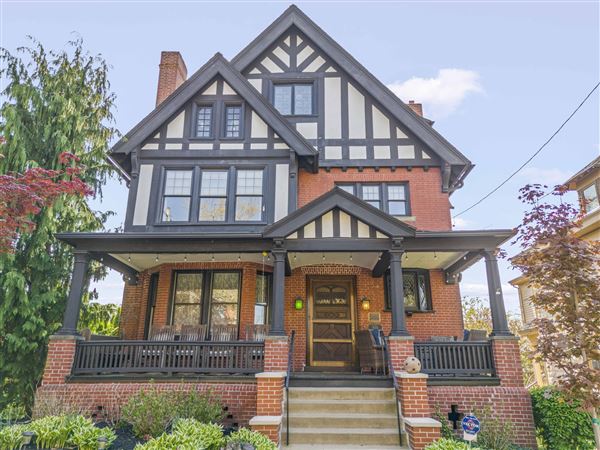Jessica Ferrell knows the danger of potholes. She fell twice because of the same one: once when she was pregnant, then again when she was carrying her newborn baby in a sling across her chest.
She wrapped her arms around her son to protect him, but injured her leg in the second fall. In April 2009, she reported the pothole near Smithfield Street and Seventh Avenue, Downtown, to the City of Pittsburgh's 311 Response Center. The pothole was filled within five workdays.
"I don't think it should take an accident to fix it," said the 32-year-old hairdresser.
The average amount of time it takes to resolve pothole complaints is on the rise on the city's streets, according to a PublicSource analysis of 25,000 pothole complaints from the 311 center between 2006 and 2012.
In 2009, it took an average of five workdays to resolve pothole complaints. The response time doubled the following year. By 2011, residents were waiting nearly three weeks. Data show that it's taking about the same amount of time to fill potholes in 2012 as in 2011.
 The Post-Gazette is a news partner of PUBLICSOURCE, a nonprofit investigative news group in Western Pennsylvania.
The Post-Gazette is a news partner of PUBLICSOURCE, a nonprofit investigative news group in Western Pennsylvania.Learn more at publicsource.org
Thirty-seven percent of the complaints over the six years were resolved within three workdays; 42 percent between four and 10 workdays; 9 percent took 11 to 20 workdays; and 10 percent took more than 20 workdays, or four weeks. The remaining 2 percent were unresolved.
As the time it takes to fill potholes climbs, so does the continuing degradation to Pittsburgh's 1,000 miles of streets. The health of its streets already is compromised because of the city's age, weather, topography and budget. And questions remain as to why some neighborhoods wait longer than others to have pothole complaints resolved.
The review of 311 data revealed the real cost of potholes: Cars with broken shock absorbers and axles. Flat tires. A radiator that fell out of a car. Motorists who swerved into oncoming traffic. Potholes outside elderly residents' high-rise apartments. Potholes in bike lanes. Pedestrians with injured arms and knees. A child with a fractured wrist.
Joanna Doven, the spokeswoman for Mayor Luke Ravenstahl, said he was unavailable to comment on the analysis, despite repeated requests by PublicSource. The city has no plans to do its own analysis of the data, she said.
During a telephone interview, Director of Public Works Robert Kaczorowski declined to speak specifically to the analysis, but he said many variables, such as steep or narrow streets and weather, can slow the response time.
- PublicSource requested and received the 311 Response Center's database from the City of Pittsburgh. It included complaint information for about 25,000 potholes.
- Complaints that did not list a resolution date were excluded. Also excluded were the complaints that were the responsibility of county, state or private entities, which totaled only 0.5 percent of the complaints.
- The analysis focused on the average number of workdays for filling potholes, excluding weekends and holidays.
- The caveat? Pothole repairs are marked as resolved on paperwork orders by public works crews. At times, the information may not be entered promptly in the 311 database.
On the day he was speaking, Tuesday, the city had only 38 outstanding pothole complaints, he said.
"Most of those will be addressed today," he said.
The data don't reflect the obstacles workers sometimes face, he said. For example, a crew recently had difficulty getting a truck down a narrow street in Lawrenceville. The men pushed wheelbarrows full of hot asphalt down the street to repair the potholes, he said.
And, because the crews document pothole repairs on paper, some potholes are filled several days before the resolution dates are entered into the 311 database, he said.
Launched in 2006 after Mr. Ravenstahl took office, the 311 call center is for all non-emergency complaints. Since 2006, 4,000 to 5,000 pothole complaints a year have poured in from bus riders, cyclists, motorists and pedestrians.
About 30,000 potholes a year are repaired in Pittsburgh. The final numbers are larger than the number of complaints because if one pothole is identified in a complaint and there are four more on the same street, the crews fill all of them.
The goal of the Public Works Department: Resolve pothole complaints within four days, said Wendy Urbanic, the call center's coordinator.
At various times, Mr. Ravenstahl's office has stated in news releases about pothole patrols that the goal for filling potholes ranges from 72 hours to five days.
At the heart of this story is a larger issue: Potholes are indicators of the health of the streets.
Think of the streets like skin. When you suffer a burn or cut, it's crucial that the wound is cared for properly, rather than just with a Band-Aid, so it doesn't become serious.
Pittsburgh is home to roughly 1,000 miles of hilly, non-gridded streets in less-than-perfect health. It's typical to see streets with repaired potholes that stretch like knotted ribbons for entire blocks, causing a bumpy ride for bicycles and cars alike.
Once water gets under the surface of a street because of a pothole, its health is compromised, and a whole box of Band-Aids won't fix the problem.
According to experts, potholes need to be filled within days.
"Once you start getting a large number of potholes, you need to resurface," said Ray Brown, emeritus director of the National Center for Asphalt Technology in Auburn, Ala.
Pittsburgh has been behind on its street resurfacing schedule for years, Mr. Kaczorowski, the public works director, told PublicSource in August, before the analysis was completed.
The city should have been resurfacing 100 miles each year, he said. However, the city could only afford to resurface 30 to 40 miles a year.
Pittsburgh's budget for filling potholes is not identified in a line item, but is part of the city's general operating budget. In 2011, the asphalt for potholes cost $260,107, according to an email from Mr. Kaczorowski.
In 2012, the Ravenstahl administration announced that 60 miles of streets would be paved at a cost of $11.3 million.
Private contractors do the resurfacing, Mr. Kaczorowski said. And this year, they are trying a new resurfacing method.
Past practice removed 3 to 5 inches of bad asphalt. But it was costly to remove that much material. The new method shaves only about an inch of asphalt off the surface of the road, Mr. Kaczorowski said. It saves money because part of the material removed is used to resurface the road.
Newly resurfaced roads should have a life of 15 to 20 years, said Mr. Brown. While the shortcuts the city is taking can cut costs, Mr. Brown warned that unless the damaged pavement is completely removed, problems, like potholes, will reappear.
"If you continue to have potholes, then you probably have a pavement design problem," Mr. Brown said.
You can get a pothole filled more quickly in some areas of the city than in others.
City Council District 5 was the loser, according to PublicSource's analysis.
Between 2006 and 2012, its residents, living in Greenfield, Glen Hazel and Squirrel Hill South, waited an average of 19 workdays for pothole complaints to be resolved.
In 2011, their pothole complaints averaged 32 workdays.
"That number really shocks me because I know our guys work really hard out there," said Corey O'Connor, the District 5 councilman.
Mr. O'Connor has been in office for nearly a year. When a constituent complains about a pothole, his office calls the local Public Works division and the pothole is fixed within days, he said.
Mr. O'Connor said he would have to see the data before raising the issue with the council.
The winner in the analysis was District 2, represented by Theresa Kail-Smith.
The district's neighborhoods include Crafton Heights and the West End and it had nearly the same number of pothole complaints as Mr. O'Connor's district. Their average for filling potholes over the six-year period was six days.
"I think with all things, there's always someone who is first," she said, adding that her district is last when it comes to other things.
Division 5 of Public Works repairs potholes in Ms. Kail-Smith's district. The supervisor of the division, John McClory, said he sends a pothole crew out as the weather permits.
And fixing potholes can be a thankless job, he said.
"The guys take some abuse," Mr. McClory said. "They just have to get back in the truck, and work."
But the job is an important one.
Jessica Ferrell said she's no longer angry about her injury that was caused by a pothole. She said she believes the 311 response center is "important for a prosperous city."
She added that she hopes areas of the city used by cyclists and pedestrians get more attention.
"People can get hurt really bad," she said. "I don't think there's any excuse for it."
First Published: November 23, 2012, 10:00 a.m.


















